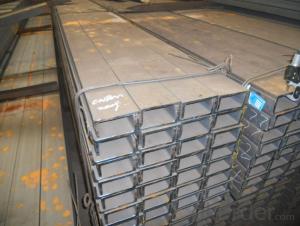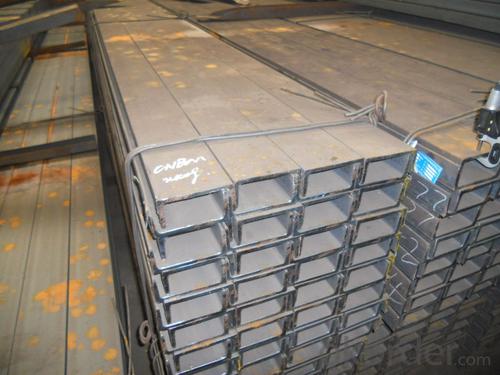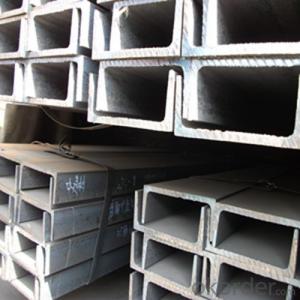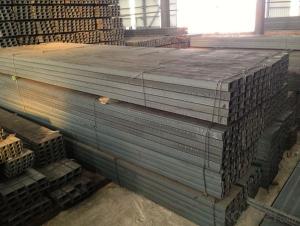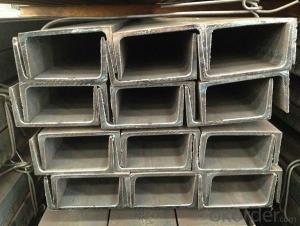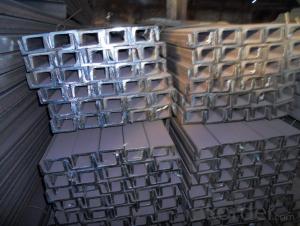Hot Rolled Steel U Channek beams for Construction of Warehouses
- Loading Port:
- Tianjin
- Payment Terms:
- TT OR LC
- Min Order Qty:
- 25 m.t.
- Supply Capability:
- 200000 m.t./month
OKorder Service Pledge
OKorder Financial Service
You Might Also Like
Product Description:
OKorder is offering Hot Rolled Steel U Channek beams for Construction of Warehouses at great prices with worldwide shipping. Our supplier is a world-class manufacturer of steel, with our products utilized the world over. OKorder annually supplies products to European, North American and Asian markets. We provide quotations within 24 hours of receiving an inquiry and guarantee competitive prices.
Product Applications:
Hot Rolled Steel U Channek beams for Construction of Warehouses are ideal for structural applications and general fabricating. The steel u channel can be applied to construction of warehouses, workshops, sport stadiums and car parks etc. In details, the steel u channel belongs to carbon structural steel which is applied to in the field of construction and machinery. The steel u channel is usually used for arch-itechtural structure, and they could be welded in order to support or hang a vari-ety of facilities. They are also usually used in combination with I beam. Generally,the steel u channel must possess perfect welding property, riveting property and mechanical property and so on.
Product Advantages:
Hot Rolled Steel U Channek beams for Construction of Warehouses are durable, strong, and resists corrosion.
Main Product Features:
· Premium quality
· Prompt delivery & seaworthy packing (7-10 days after receiving deposit)
· Corrosion resistance
· Can be recycled and reused
· Mill test certification
· Professional Service
· Competitive pricing
Product Specifications:
Hot Rolled Steel U Channek beams for Construction of Warehouses Details:
Minimum Order Quantity: 25 Tons Unit: m.t. Loading Port: Xingang Port
Supply Ability: 1000 Tons Per Day Payment Terms: TT or L/C
Product Description:
Specifications of Steel U Channel:
Standard Applied: GB Standard, EN Standard(UPN), JIS Standard
Sizes: 50mm to 300mm
Material Grade: Q235B, Q345B, S235JR, SS400, ASTM A36
As shown in the figure:
| JIS U CHANNEL | Standard h | Sectional b | Dimension s | t | Mass: Kg/m |
| (mm) | (mm) | (mm) | (mm) | ||
| 50x25 | 50 | 25 | 3.0 | 6.00 | 2.37 |
| 75X40 | 75 | 40 | 3.8 | 7.00 | 5.30 |
| 75X40 | 75 | 40 | 4.0 | 7.00 | 5.60 |
| 75X40 | 75 | 40 | 4.5 | 7.00 | 5.85 |
| 75X40 | 75 | 40 | 5.0 | 7.00 | 6.92 |
| 100X50 | 100 | 50 | 3.8 | 6.00 | 7.30 |
| 100X50 | 100 | 50 | 4.2 | 6.00 | 8.03 |
| 100X50 | 100 | 50 | 4.5 | 7.50 | 8.97 |
| 100X50 | 100 | 50 | 5.0 | 7.50 | 9.36 |
| 125X65 | 125 | 65 | 5.2 | 6.80 | 11.66 |
| 125X65 | 125 | 65 | 5.3 | 6.80 | 12.17 |
| 125X65 | 125 | 65 | 5.5 | 8.00 | 12.91 |
| 125X65 | 125 | 65 | 6.0 | 8.00 | 13.40 |
| 150x75 | 150 | 75 | 5.5 | 7.30 | 14.66 |
| 150x75 | 150 | 75 | 5.7 | 10.00 | 16.71 |
| 150x75 | 150 | 75 | 6.0 | 10.00 | 17.90 |
| 150x75 | 150 | 75 | 6.5 | 10.00 | 18.60 |
FAQ:
Q1: Can Hot Rolled Steel U Channek beams for Construction of Warehouses rust?
A1: Hot Rolled Steel U Channek beams for Construction of Warehouses do not "rust" as you think of regular steel rusting with a red oxide on the surface that flakes off. If you see red rust it is probably due to some iron particles that have contaminated the surface of the stainless steel and it is these iron particles that are rusting. Look at the source of the rusting and see if you can remove it from the surface.
Q2: What is the normal tolerance of Hot Rolled Steel U Channek beams for Construction of Warehouses?
A2: Normally 3%-5%, but we can also produce the goods according to the customers' requests
Q3: The products are invoicing on theoritical weight or on actual weight?
A3: We can do it in both manners, according to the customers' request.
duce the goods according to the customers' requests
- Q: How do steel channels contribute to the overall aesthetics of a building?
- Steel channels can contribute to the overall aesthetics of a building by providing clean lines, sleek finishes, and a modern appearance. Their structural design allows for versatility in architectural designs, enabling the creation of unique and visually appealing features. Additionally, steel channels can be used to create stunning facades, giving buildings a contemporary and sophisticated look.
- Q: Can steel channels be used in the agricultural manufacturing industry?
- Indeed, the agricultural manufacturing industry can utilize steel channels. These flexible and enduring structural elements possess the capability to serve diverse functions within agricultural manufacturing. They can contribute to the creation of machinery, equipment, and infrastructure, including barns, sheds, and storage facilities. Steel channels offer robustness and stability, qualifying them for supporting substantial burdens and enduring the demanding environmental conditions frequently encountered in the agricultural sector. Moreover, steel channels can be effortlessly fabricated, welded, and adjusted to fulfill precise design prerequisites, rendering them a favored option in agricultural manufacturing.
- Q: Channel structure, angle steel, I-beam and so on, if not painted, the impact on life?
- With the continuous improvement of the quality of engineering, steel structure steel, steel, steel and other sections shall be made and preserved in use, if not treated will have great influence on the service life of workpieces. From the point of view of comprehensive cost and effectiveness of anti-corrosion treatment, hot-dip galvanizing, which is called "Iron Guard", should be the first choice for corrosion protection. The paint can only be used as protective treatment of the short term, it is low cost, fast construction but every 1-2 years for a brush maintenance, time-consuming late high cost galvanizing treatment at a time can keep 30-50 years or even permanent, because this has a great relationship with it service environment, coastal and inland, heavy industry District and country are very different.
- Q: Are steel channels suitable for modular furniture?
- Certainly, modular furniture can indeed be made using steel channels. These channels possess robustness and longevity, making them a perfect choice for furniture that must endure substantial weight and frequent usage. Not only do they provide stability and support, but they also lend themselves well to a variety of modular furniture designs, including shelving units, desks, and cabinets. Moreover, steel channels can be effortlessly customized and trimmed to specific lengths, enabling flexible and modular designs. Additionally, they offer a sleek and contemporary appearance, making them highly favored for modern furniture styles. All in all, steel channels emerge as a dependable and versatile material for modular furniture, offering both practicality and aesthetics.
- Q: What are the different types of support brackets for steel channels?
- There are several types of support brackets commonly used for steel channels, including U-shaped brackets, L-shaped brackets, T-shaped brackets, and adjustable brackets. Each type of bracket is designed to provide specific support and stability for steel channels in different applications and load conditions.
- Q: What are the different types of hangers used for steel channels?
- There are several different types of hangers used for steel channels, including clevis hangers, u-bolt hangers, pipe hangers, and beam clamps. These hangers are designed to provide support and secure the steel channels in various applications, such as construction, plumbing, and electrical installations. Each type of hanger has its own specific design and mounting method to accommodate different channel sizes and load capacities.
- Q: Are steel channels suitable for coastal applications?
- Yes, steel channels are suitable for coastal applications. Steel channels are commonly used in coastal areas due to their durability and resistance to corrosion. Coastal environments pose unique challenges such as high humidity, saltwater exposure, and strong winds, which can accelerate the deterioration of materials. However, steel channels are specifically designed to withstand these conditions. They are typically made from stainless steel or galvanized steel, which have a protective layer that prevents rust and corrosion. Moreover, steel channels offer excellent strength and structural integrity, making them suitable for coastal applications such as seawalls, docks, piers, and other marine infrastructure.
- Q: Can steel channels be used for handrail supports?
- Yes, steel channels can be used for handrail supports. Steel channels are commonly used in construction for their strength and durability, making them an ideal choice for handrail supports. They provide stability and support to the handrail, ensuring its safety and longevity. Additionally, steel channels can be easily customized and fabricated to fit specific handrail designs and requirements.
- Q: What are the different methods of anti-slip treatment for steel channels?
- There are several different methods of anti-slip treatment for steel channels, each offering their own advantages and suitability for specific applications. Some of the commonly used methods include: 1. Grip tape: This is a cost-effective solution that involves applying adhesive-backed tape with a textured surface onto the steel channel. Grip tape is easy to install and provides good traction, making it suitable for areas with light to moderate foot traffic. 2. Anti-slip coatings: These coatings are specially designed to create a rough surface on the steel channel, enhancing slip resistance. They can be applied using a brush, roller, or spray, and are available in various materials such as epoxy, polyurethane, or acrylic. Anti-slip coatings are durable and can withstand heavy foot traffic, making them suitable for industrial environments. 3. Perforated plates: These are steel plates with small holes punched throughout their surface, allowing water or other liquids to drain through and reducing the risk of slipping. Perforated plates are often used in outdoor areas or where liquids are present, such as walkways, platforms, or stair treads. 4. Expanded metal: This is a type of steel sheet that is slit and stretched to create a pattern of diamond-shaped openings. The raised surface of expanded metal provides excellent anti-slip properties, making it suitable for ramps, stair treads, or catwalks. Expanded metal is also durable and resistant to corrosion, enhancing its longevity. 5. Welded serrated grating: This method involves welding serrated bars onto a steel channel, creating a rugged surface that improves traction. Welded serrated grating is commonly used in heavy-duty applications, where high slip resistance is required, such as oil rigs, power plants, or manufacturing facilities. It's important to consider the specific requirements of the steel channel and the intended usage when selecting an anti-slip treatment method. Factors such as foot traffic, exposure to liquids, and the need for durability should be taken into account to ensure the chosen method is appropriate for the application.
- Q: Can steel channels be used in renewable energy installations?
- Yes, steel channels can be used in renewable energy installations. Steel channels are commonly used in various renewable energy applications, such as solar panel mounting systems and wind turbine support structures. The durability and strength of steel make it an ideal material for withstanding the environmental conditions and load requirements in renewable energy installations. Additionally, steel channels can be easily fabricated and customized to meet the specific needs of different renewable energy projects.
Send your message to us
Hot Rolled Steel U Channek beams for Construction of Warehouses
- Loading Port:
- Tianjin
- Payment Terms:
- TT OR LC
- Min Order Qty:
- 25 m.t.
- Supply Capability:
- 200000 m.t./month
OKorder Service Pledge
OKorder Financial Service
Similar products
Hot products
Hot Searches
Related keywords
